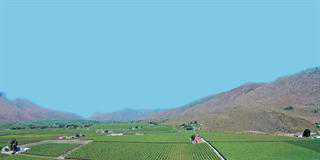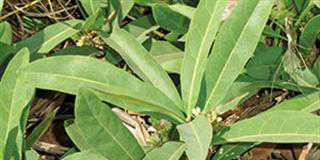Fruit farmer Ian de Kock of Harmonie farm near Montagu in the Western Cape, says the use of fulvic and amino acids has improved crop health, yields and fruit quality while reducing the dependence on fertiliser. Glenneis Erasmus reports.
Increased awareness of the adverse effect of chemicals on the environment prompted Ian de Kock to incorporate organic acids, and more specifically fulvic and amino acids, into his farm Harmonie’s soil nutrition programme. Ian claims this production shift has resulted in a significant reduction in the amount of fertilisers used on the farm.
The annual crop nutrition plan now consists of a two-week fertigation programme, where a mixture of Up Gro – a fulvic acid formulation with amino acids – and potassium is applied one week, and phosphates are applied in the form of MAP every other week.
He no longer has to apply any nitrogen to these crops, and the fact that Up Gro improves a plant’s ability to absorb nutrients has also resulted in a reduction in the amount of potassium and phosphates used in the programme. F or perennial crops, the use of Up Gro in combination with urea – a source of nitrogen – has led to at least a 10% reduction in the amount of urea used on the farm.
The nutrition programme is combined with a potjie system (see What are potjies?) in suitable orchards to enhance uptake even more. The system is, for example, not used on apricots with wild plum rootstocks, because it would over-stimulate vegetative growth of the rootstock.
It is only used a year after plants are established, to compensate for shrinkage and stretching of the irrigation pipes. “New irrigation pipes often change after they are put into action, resulting in the dripper often not supplying the same area with fertigation as when it was established. By waiting for the pipes to set before we make potjies, we ensure that fertigation will drip into the holes,” Ian explains.
In contrast, new plants are planted with compost. What are potjies? Potjies are 30cm-deep and 5cm-diameter holes regularly filled with compost made from farm waste. The holes are positioned so that fertigation consisting of Up Gro along with urea and other soil nutrients drip straight into them, and their basic aim is to concentrate root growth in these nutrient-rich areas.
Each tree or vine has access to one to three potjies depending on the plant, soil type and nutritional demands of the crop.
Amino Stim, another fulvic and amino acid formulation, has also helped to reduce the amount of nutrients required on especially heavy compact soil with high pH levels. “Soil compaction not only limits the water- and nutrient-holding capacity of the soil, but also impedes root growth and in effect decreases the plant’s ability to absorb nutrients and water.
Reduced soil aeration also affects root metabolism. All of these factors increase the amount of stress on plants and make them more susceptible to disease. Fruit quality and yields are also affected,” explains Danie Pienaar, consultant of Terra Dynamics. He adds that Amino Stim increases soil amelioration and stimulates root growth and microbial activity in the soil: “improved root systems allow plants to penetrate the soil more easily and absorb soil nutrients and water over a wider area.
Amino Stim also increases microbial activity and in effect helps to improve soil aeration and the water- and nutrient-holding capacity of the soil, so less nitrogen is lost due to denitrification – the loss of nitrate-nitrogen to the atmosphere.
”The incorporation of fulvic acids, in addition to saving costs by reducing the amount of nutrients used in the soil fertiliser programmes, has helped to improve plant health, increase yields and fruit quality since Ian started using these products three years ago. he stronger roots and reduced stress has, for example, led to the cancellation of the alternate-bearing phenomenon of apricots at Harmonie. “Apricot production has basically stabilised and we no longer have years where production drops to almost nothing.
In addition to this we have more first-grade fruit than in the past, and the shelf life of products is also longer than it used to be,” Ian says.
Even the production life of some of the trees has been increased on the farm. “We had one vineyard that was over 40 years old. Little growth, and the small grape bunches and berry sizes, signalled that the vineyard was close to the end of its production life. However, we applied an intensive programme which incorporated fulvic acids to this vineyard, and have managed to greatly enhance the production life of these trees. Today they are again producing commercially viable yields,” Ian says. He adds that average apricot production has increased from 22t/ha before the system was used to 35t/ha. Some orchards even produce more than 40t/ha. Gooseberry production increased from 7t/ha to 12,8t/ha.
Merlot and Pinotage vineyards also receive Terra Boost – a fulvic acid-formulated foliar feed mix for the supplement of potassium, calcium, magnesium, zinc, boron and molybdenum – after veraison to improve fruit set and fruit quality. “The product stimulates the production of berries with more juice and thicker skins, and in effect helps to enhance the ultimate quality and colour of the wine produced, ” Ian says.
Terra Boost can be supplied via fertigation, but would then require larger volumes. Ian at the moment only has to apply 5 litres per hectare. Ian has also been using terra-zinc on apricots at 10% flowering to enhance fruit set. “Climatic conditions were not conducive to fruit set and we therefore had to apply this product.
Fruit set as a result of this was so heavy in some orchards that we had to severely prune the trees later,” Ian says.
Trees prosper
Ian claims a prominent fertiliser company advised him against planting apricots in one piece of the land due to the high clay content of this soil. Two years later, and these trees are looking just as healthy and are in even better shape than some of the trees that were planted in high-quality soil. The same happened to Joshua Coetzee, farm manager of Na Die Oes in Bonnievale. “Vinpro told us we would be crazy to establish a vineyard on one section of the land due to the high lime content and low pH of this land. A vineyard would never grow here, they told us.” However, both these farmers managed to establish these crops in these respective lands with the help of nutritional programmes incorporating fulvic and amino acids, which were developed by Terra Dynamics based on soil and leaf analysis results. “We established a vineyard of Shiraz on this 4,5ha of land and the vines literally stopped growing two or three months after they were established. We thought we were going to lose the whole vineyard, but Terra Dynamics fortunately proposed that we incorporate fulvic and amino acids in the production programme. The results were amazing and the vines are growing much better than we ever thought would be possible,” Joshua exclaims.
The success of this programme has been so remarkable that Joshua is now using a similar programme on an additional 30ha of vineyard on the farm. Terra Maize has also been used on maize, as silage for dairy cows, and another fulvic acid product is used once a year on lucerne pastures to improve root formation and the water absorption capacity of the plants. Paul Jordaan, who farms at Bordeaux just outside Montagu has had a similar experience with a Steen grape vineyard. He planted 2ha of vineyard in extremely saline soil in August 2005 – the pH was around 8 and the sodium levels were almost 10,1 units. He knew he had to get a solution fast or he would have lost the vineyard. Danie suggested he use Amino Stim to break down the sodium levels in the soil and to enhance root development.
Amino Stim has the added advantage of improving protein synthesis in the roots and thereby improving the production of cytokinins, which stimulate plant growth. Up Gro was also added to the programme to break down nutrients so they are more easily absorbed by plants, and Bio-B was added to enhance the soil quality and restore the natural and biological balance of the soil, and enhance its water and nutrient content. Paul has harvested almost 25 tons of wine grapes from this vineyard this year and he has established another 2ha of wine grapes on similar soil last year. Contact Danie Pienaar on 083 226 1554 or e-mail [email protected]. |fw













